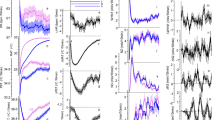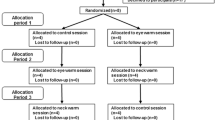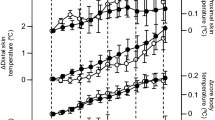Abstract
A fall in body temperature due to circadian rhythms causes drowsiness and increases the propensity to sleep from the evening to midnight. As one of the sources of declining body temperature, the occipital region was cooled with a water pillow in this study, and the effect of this cooling technique on the sleep process and subjective ratings of sleep was analyzed. Seven university students whose sleep latency was more than 30 min slept using a pillow with a surface temperature 16°C (iced water condition) or 26°C (room temperature water condition), respectively. The iced water decreased the axilla temperature faster than the water at room temperature. A polysomnogram analysis indicated that sleep latency was significantly shorter when iced water was used compared to when cool water at room temperature was used. In addition, the iced water improved the participants’ subjective quality of sleep, including falling asleep and sleep maintenance. These results suggest that cooling the occipital region might be effective in promoting sleep onset and sleep maintenance.
Similar content being viewed by others
References
American Sleep Disorders Association. ICSD: International Classification of Sleep Disorders: Diagnostic and Coding Manual. The Association: Rochester, MI 1990.
Kim K, Uchiyama M, Okawa M et al. Lifestyles and sleep disorders among the Japanese adult population. Psychiatry Clin. Neurosci. 1999; 53: 269–70.
Mitler MM, Carskadon MA, Czeisler CA et al. Catastrophes, sleep and public policy: consensus report. Sleep 1988; 11: 100–9.
Kobayashi T, Yoshida H, Ishikawa T et al. Effects of the late evening exercise on sleep onset process. Sleep Res. Online 1999; 2 (Suppl 1): 233.
Yoshida H, Ishikawa T, Shiraishi F et al. Effects on the timing of exercise on the night sleep. Psychiatry Clin. Neurosci. 1998; 52: 139–40.
Bunnell DE, Agnew JA, Horvath SM et al. Passive body heating and sleep: influence of proximity to sleep. Sleep 1988; 11: 210–19.
Czeisler CA, Weitzman ED, Moore-Ede MC et al. Human sleep: its duration and organization depend on its circadian phase. Science 1980; 210: 1264–7.
Krauchi K, Wirz-Justice A. Circadian clues to sleep onset mechanisms. Neuropsychopharmacology 2001; 25: S92–6.
Murphy PJ, Campbell SS. Nighttime drop in body temperature: a physiological trigger for sleep onset? Sleep 1997; 20: 505–11.
Zhu M, Ackerman JJH, Sukstanskii AL et al. How the body controls brain temperature: the temperature shielding effect of cerebral blood flow. J. Appl. Physiol. 2006; 101: 1481–8.
Tsuzuki K, Okamoto-Mizuno K, Mizuno K. Effects of humid heat exposure on sleep, thermoregulation, melatonin, and microclimate. J. Therm. Biol. 2004; 29: 31–6.
Rechtschaffen A, Kales A, eds. A Manual of Standardized Terminology, Techniques and Scoring System for Sleep Stages of Human Subjects. NIH Publication 204. Government Printing Office: Washington, DC, USA, 1968.
Oguri M, Shirakawa S, Azumi K. Construction of standard rating scale to estimate sleep profile. Seishinigaku 1985; 27: 791–9.
Shirakawa S, Oguri M, Azumi K. Polysomnographic parameters having influence on sleep profile. Sleep Res. 1989; 18: 288.
Krauchi K, Cajochen C, Werth E et al. Functional link between distal vasodilation and sleep-onset latency? Am. J. Physiol. Regul. Interg. Comp. Physiol. 2000; 278: 741–8.
Sagot JC, Amoros C, Candas V et al. Sweating responses and body temperatures during nocturnal sleep in humans. Am. J. Physiol. 1987; 252: 462–70.
Nelson DA, Nunneley SA. Brain temperature and limits on transcranial cooling in humans: quantitative modeling results. Eur. J. Appl. Physiol. 1998; 78: 353–9.
Williams RL, Karacan I, Hursch CJ. Electroencephalography (EEG) of Human Sleep: Clinical Applications. Wiley: New York, 1974.
Author information
Authors and Affiliations
Corresponding author
Rights and permissions
About this article
Cite this article
Setokawa, H., Hayashi, M. & Hori, T. Facilitating effect of cooling the occipital region on nocturnal sleep. Sleep Biol. Rhythms 5, 166–172 (2007). https://doi.org/10.1111/j.1479-8425.2007.00270.x
Received:
Accepted:
Published:
Issue Date:
DOI: https://doi.org/10.1111/j.1479-8425.2007.00270.x




